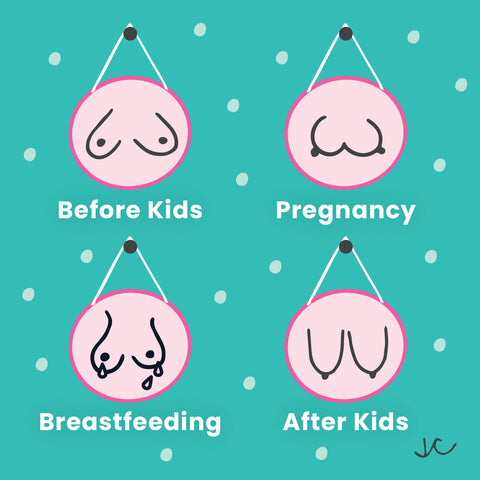Our Top Tips For How To Pump And Store Breast Milk Safely
You know what Breastie?
Breastfeeding your little milk monster is so rewarding and wonderful. But it’s a heck of a lot of work.
Are we right?
And whether you breastfeed or pump, or pump exclusively, the work you put into creating amazing milk for your little one is just inspiring.
For mamas who pump, it can be a confusing world out there. There are so many questions and concerns we hear on a daily basis about how to pump and store breast milk, how to store breast milk in the fridge, and how to pump breast milk manually, that we thought, you know what? Let’s create a helpful little guide to help our pumping queens out.
So mama, sit back, relax with a cup of coffee in your fave Titty City mug, and read on. Here are our best pumping tips and tricks.
Pumping tips and tricks
The most important thing to know about pumping is that no pumping journey is the same. Breast pumping experiences vary from mama to mama, so don’t compare yourself to others. Although we know it’s hard not to sometimes.
Some amazing mamas pump because they had issues breastfeeding, others because they prefer it, others for health reasons, some because they’re going back to work… every journey is different and each one needs to be celebrated.
And, let’s be totally real with each other Breast Friend. Pumping is a heck of a lot of hard work and isn’t always the most enjoyable or relaxing experience. BUT. Yay there’s a but. If you follow these pumping tricks, it can make your pumping journey a little easier and less of a big milky deal.
#1 Be prepared in advance
Being prepared is the best advice for most situations, but even more so when it comes to pumping.
If you feel you want to breastfeed when you’re pregnant, then start doing your research, early Breast Friend.
Look at different pumps and take into consideration your needs. Speak to other women who have pumped to get their opinions on different models and then spend time looking at them online or in-store. Pumps range from manual to electric, plug-ins or battery run, single pumps, and doubles. There are a lot of options out there to suit all budgets, and a provision of the Affordable Care Act has been in effect since 2013 to help cover the cost of some pumps.
You can even rent hospital-grade pumps if you want to borrow them instead of owning one.
It’s also critical to have a breast shield (or flange) that fits properly. Shields should fit over your nipple and form a seal around your areola.
Whichever pump you choose, make sure you thoroughly read the instructions before operating it, including how to clean it properly.
#2 Learn how to breast pump manually
You don’t need to use a pump if that’s not your thang. It’s totally doable to hand express your milk, as long as you know how to do it safely. In fact, it’s one of our favorite breast pumping tips for new moms.
Breast pumping manually is convenient and cost-efficient and is a simple way to build a stash, relieve feelings of fullness, and get familiar with your fabulous Boobies. As long as you have clean hands, patience, and storage for your magic milk then you’re good to go!
Here are our top hand pumping tips:
-
Make sure your hands and storage equipment is clean, then go to a calm, quiet room and bring along a snack and some water
-
Encourage your “let-down” reflex by gently rolling your nipple between your thumb and finger and massaging your breasts in a circular pattern. Try to relax (stress and anxiety can get in the way of the reflex.) And be patient Breastie. This process can take a few minutes
-
Support your Boobie with your hands and position your thumb and fingers on your breast. Next, place your thumb and first two fingers on your areola
-
Press your thumb and fingers towards your chest and (slowly) bring them together. Don’t squeeze your nipples. You want to be compressing your breast and areola
-
Now rotate your thumb and fingers in a clockwise direction and repeat the same motions. Do this around your whole breast until the flow of milk slows or stops
-
Then switch breasts and do the same thing again! You can go back and repeat this process on both Boobies until the milk slows or your breasts feel soft and less full
Remember mama, it can take several days or even weeks until you see an increase in milk. You’ll probably have small amounts at first but just keep at it. You’ve got this!
#3 Get started early
If you’re heading back to work and want to continue nursing (you superwoman you) then pumping is your way forward. The best pumping tips at work are all about getting started early.
Start pumping two to four weeks before you’re due back at work. Most lactation consultants recommend adding one pump session per day on top of your baby’s usual feeds and storing that milk. This is also a great way to build a breast milk stash!
Because breast milk is a demand and supply process, the more you feed and pump, the more milk you’ll make. So don’t worry about running out! If anything, you’ll make more.
Some other pumping tips at work? Bring a spare change of clothes with you in case of any milk mess, extra breast pads, and even invest in your own mini-fridge to keep your milk stashed safely. Have a talk with your work before going back and let them know you’re breastfeeding and let them know what your needs are.
#4 Look at pictures of your baby
As well as being super adorable, looking at a picture or video before and during pumping can help encourage your let-down and supply.
It’s usually easier to feed a baby than a pump, as your body produces lots of oxytocin - the love hormone. But, if you’re not with your baby, then looking at pictures or videos is the next best thing.
#5 Pump often
When you pump or breastfeed often it increases your milk supply. This is a breastfeeding tip for new moms and all nursing moms to be aware of. If you pump more frequently rather than for longer periods, your milk supply will go up!
Pretty cool, right?
So, instead of doing two looooong pumps a day, try doing three or four shorter pumping sessions. Bonus tip - if you pump both Boobies at the same time, you can increase the yield of milk you get!
This leads us to this pumping tip…
Don’t skip pumping! If you skip a session, it can have a negative effect on your supply. If you don’t have time for a full session, just pump for even a few minutes to send the right signals to your milk-makers. If you don’t have your pump with you, hand express using the hand pumping tips above.
#6 Nurse exclusively when you're with your babe
If you breastfeed, then use any time you’re with your baby to nurse, and save the pump for when you’re apart.
Nursing can help keep your supply abundant and give you that precious bonding time. Make breastfeeding the last thing you do before going to work or heading out, and the first thing you do when you’re reunited.
And on the weekends and holidays, enjoy as many nursing sessions as you both want to keep your supply up and your bond beautiful.
#7 Set up a pumping schedule
If you’re planning to exclusively pump and want a good supply then a pumping schedule is key. Routine, regular pumping will help you produce the maximum amount of milk.
Although this might seem like a lot of effort, it is so worth it. In the early days, you could be pumping every two hours to build up your production, but after a while, your body will adjust to its natural supply.
Write your schedule down and put it somewhere you can always see it. You might also find it helpful to put alerts or reminders on your phone when it’s time to pump.
#8 Eat well and stay hydrated
Staying hydrated is super important for milk production. Breastfeeding mamas need to be chugging about 13 cups of liquids a day.
And as for food, well yes. You deserve treats. You’re working so hard mama but try and maintain a healthy, well-balanced diet. There are some foods you can eat that also supposedly help increase supply.
Oatmeal is the number one choice. It’s also super healthy and filling, so make it your breakfast of choice a few times a week. Other great foods for helping milk supply include fenugreek seeds, spinach, basil, garlic, brown rice, flax seeds, brewer’s yeast, and sweet potatoes.
How to store breast milk at home
Now you are a certified pumping queen, it’s important to know how to store breast milk at home or in the office.
Breastmilk is OK to keep for up to four hours at room temperature, so there’s no immediate rush to get to the fridge if you’ve just pumped. You can store milk in the fridge for up to four days (but not in the door compartment). If you know you aren’t going to use your pumped milk within four days, then it’s better to be safe and freeze it. You can store it in the freezer for up to six months.
Okay. Now the storage rules are outta the way, here are some tips for storing your milk including how to store breast milk in the fridge.
Store your breast milk in small batches
To ensure your Titty milk doesn’t go to waste, it’s always best to store in smaller batches. You can buy breast milk storage bags online or in stores, which hold your milk safely and securely. If you aren’t a fan of the bags, then why not try a clean, capped food-grade glass container?
It’s recommended to make stashes of around two to four ounces but you can always up this or lessen it depending on how much milk your baby takes from the bottle.
Always label your storage bags/containers
Before you add your milk to your container, label them with the date (and your baby’s name if they go to daycare) the milk was expressed. This will help you keep on top of how old or fresh the milk is.
Some other tips to consider
- Leave an inch or so from the milk to the top of the container, as it expands when freezing
- Stored milk can vary in color - your magical milk can be yellowish, bluish, creamy, or even brownish!
- It’s normal for your milk to separate, with the fatty part of the milk on the top. Just shake the bag or bottle to mix it back up
- Give the milk a little sniff before giving it to your baby. If it smells sour, then chances are it’s gone bad and would need to be discarded. When in doubt, take a little taste
- When freezing your milk, stash it in the back of the freezer, not on the shelf of the freezer drawer
How to warm breast milk from the fridge
First thing’s first. When warming or thawing your milk, always use the oldest breast milk first.
Your baby is used to having their mama’s milk at body temperature - if they breastfeed. So, you can either let your milk get to room temperature or warm it slightly by running it under warm (not hot) water or placing it in a container with warm water.
Always test the temperature before giving it to your baby and give it to them within two hours.
To thaw your milk from frozen, put it in your fridge overnight so it thaws gently, and always use it within 24 hours from when the breast milk is no longer frozen. One last thing, do not refreeze your milk after it has thawed Breastie.
Pumping is hard work
But your not alone mama.
You are strong, determined, and powerful, and you are giving your baby the very best start. And we are so proud of you.
We hope that our guide for how to pump and store breast milk safely has helped you with your pumping journey. Why not head over to the Titty City Instagram page and let us know how you’re getting on?
At Titty City Design, we believe that every boobie is beautiful, and that should be celebrated. We are a female owned and operated, small business here to spread self love and body positivity with our line of products for the home. A portion of our proceeds go to help support postpartum women and breast cancer patients.
Products that New Moms Love








